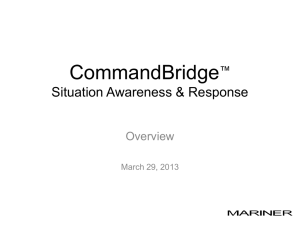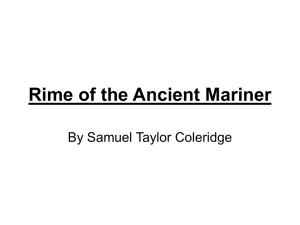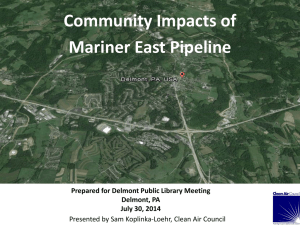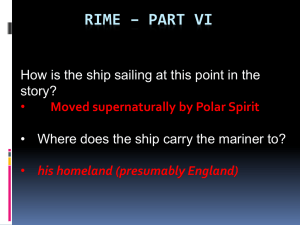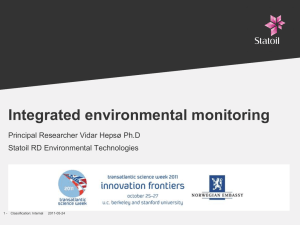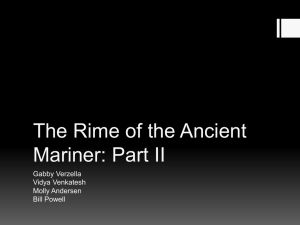Basil Appraisal Well Environmental Statement Block 12/21c
advertisement
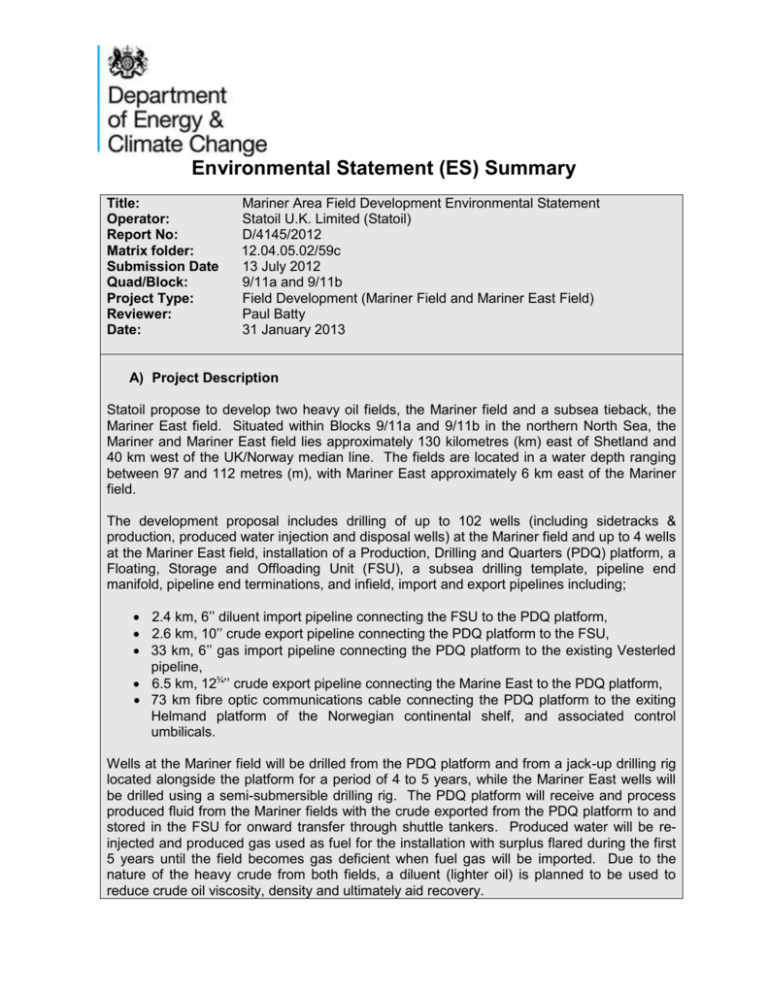
Environmental Statement (ES) Summary Title: Operator: Report No: Matrix folder: Submission Date Quad/Block: Project Type: Reviewer: Date: Mariner Area Field Development Environmental Statement Statoil U.K. Limited (Statoil) D/4145/2012 12.04.05.02/59c 13 July 2012 9/11a and 9/11b Field Development (Mariner Field and Mariner East Field) Paul Batty 31 January 2013 A) Project Description Statoil propose to develop two heavy oil fields, the Mariner field and a subsea tieback, the Mariner East field. Situated within Blocks 9/11a and 9/11b in the northern North Sea, the Mariner and Mariner East field lies approximately 130 kilometres (km) east of Shetland and 40 km west of the UK/Norway median line. The fields are located in a water depth ranging between 97 and 112 metres (m), with Mariner East approximately 6 km east of the Mariner field. The development proposal includes drilling of up to 102 wells (including sidetracks & production, produced water injection and disposal wells) at the Mariner field and up to 4 wells at the Mariner East field, installation of a Production, Drilling and Quarters (PDQ) platform, a Floating, Storage and Offloading Unit (FSU), a subsea drilling template, pipeline end manifold, pipeline end terminations, and infield, import and export pipelines including; 2.4 km, 6’’ diluent import pipeline connecting the FSU to the PDQ platform, 2.6 km, 10’’ crude export pipeline connecting the PDQ platform to the FSU, 33 km, 6’’ gas import pipeline connecting the PDQ platform to the existing Vesterled pipeline, 6.5 km, 12¾’’ crude export pipeline connecting the Marine East to the PDQ platform, 73 km fibre optic communications cable connecting the PDQ platform to the exiting Helmand platform of the Norwegian continental shelf, and associated control umbilicals. Wells at the Mariner field will be drilled from the PDQ platform and from a jack-up drilling rig located alongside the platform for a period of 4 to 5 years, while the Mariner East wells will be drilled using a semi-submersible drilling rig. The PDQ platform will receive and process produced fluid from the Mariner fields with the crude exported from the PDQ platform to and stored in the FSU for onward transfer through shuttle tankers. Produced water will be reinjected and produced gas used as fuel for the installation with surplus flared during the first 5 years until the field becomes gas deficient when fuel gas will be imported. Due to the nature of the heavy crude from both fields, a diluent (lighter oil) is planned to be used to reduce crude oil viscosity, density and ultimately aid recovery. The Mariner field has an estimated 40 year field life and an estimated 57 million tonnes (Mt) of recoverable reserves. Mariner East field has an estimated 8 year field life with 2.3 Mt recoverable reserves of heavy crude oil. Pipelay operations to install the infield, export and import pipelines will be conducted using a dynamically positioned (DP) reel-lay vessel, DP S-lay vessel and/or an anchored lay vessel. The pipelines will be trenched and buried and an estimate of up to 500,000 m3 of rock and concrete mattresses will be required to mitigate against upheaval buckling, and to protect pipeline crossings and subsea infrastructure. Installation of the Mariner jacket is expected to commence in 2015 with the topsides and FSU in 2016. First oil is expected in Q1 2017. Drilling on Mariner East is expected to start in 2018 with first oil in Q1 2019. All activities will be subject of an Oil Pollution Emergency Plan (OPEP) that will need to be approved prior to commencement of operations. B) Key Potential Environmental Impacts The Environmental Impact Assessment (EIA) identified the following key activities as having the potential to cause an environmental impact: Drilling – combustion emissions, well clean-up emissions, drill rig anchors, rig and vessel noise, accidental hydrocarbon spills. Installation – combustion emissions, subsea infrastructure and pipelines installation, rock dumping, subsea infrastructure installation noise, hydrotest discharges, accidental spills. Production – atmospheric emissions, accidental hydrocarbon spills. Wider concerns – accidental events, transboundary issues, cumulative effects C) Key Environmental Sensitivities The EIA identified the following environmental sensitivities: Fish: The development is in an area where there are fish / shellfish spawning and/or nursery areas for Cod, Whiting, Blue whiting, Haddock, Saithe, Norway pout, Nephrops, Sandeel, Mackerel, Ling, European hake, Angler fish and Herring. The spawning and nursery areas are extensive and the area of impact would be localised and temporary. Therefore the drilling of wells and pipelay is unlikely to impact these species. Seabirds: Seabird vulnerability is very high in October and November, high in January and July, moderate to low in months throughout the remainder of the year. It has been assessed that there are sufficient mitigation measures in place to prevent accidental spills that could have a significant impact on seabirds and this will be covered in detail by the OPEP. Protected habitats: There are no designated protected sites in the vicinity of the proposed development, including Annex I habitats as defined by the Habitats Directive. The closest identified Annex I habitats are the Scanner Pockmark, Special Area of Conservation (cSAC), located 145 km south and the Braemar Pockmarks (cSAC) located 70 km respectively south of the proposed development. The Pobie bank (pSAC) is located 130 km north west of the proposed development. Page 2 of 4 Protected species: Harbour porpoise is the only Annex II species found in the area. The occurrence is very high in February, high in July, moderate August and September. Grey and Common Seals inhabit the coastal waters around the North Sea and have occasionally been observed to travel long distances when foraging, both species are unlikely to be present in large numbers at the proposed development area. Any disturbance of marine mammals is expected to be limited to the drilling period and during installation of subsea infrastructure, and the localised disturbance is considered unlikely to have any significant impact. Other Users of the Sea: The proposed development is situated within ICES rectangle 48F1, and relative fishing effort in the area is low. Shipping density in the vicinity of the proposed development is low. Appropriate navigational controls will be put in place, and it is not anticipated that there will be any significant impact on other users of the sea. The closest renewable energy zone is located 350 km southwest of the proposed development. D) Consultation The Joint Nature Conservation Committee (JNCC), Marine Scotland (MS), the Maritime and Coastguard Agency (MCA), Northern Lighthouse Board (NLB) and the Ministry of Defence (MoD) were consulted on the proposals. The ES was also subject to Public Notice. JNCC: JNCC confirmed that adequate measures have been put in place to minimise the potential impacts of the activities on the marine environment. JNCC had requested additional information of the noise modelling and clarity on flaring. Following submission of additional information JNCC had no further comments. MS: MS confirmed that there were no objections to the proposed development, but have noted to make an informed chemical risk assessment at the PON15B and PON15C application stage, and had requested copies of survey reports. NLB: NLB confirmed that there were no objections and advised that the permanent infrastructure on the seabed must be communicated to UK Hydrographic Office to ensure updating of all relevant admiralty charts. MCA: MCA confirmed that there were no objections. MoD: MOD confirmed that there were no objections. Public Notice: No comments were received in response to the Public Notice. E) Further Information Further information was requested from Statoil to address issues raised by the consultees and identified during the internal DECC OGED review, which included clarity on survey information, power generation, emissions and flaring, modelling of drill cuttings dispersal, noise assessment and sediment contamination levels. Additional information was provided by Statoil on 23 November 2012, 19 December 2012 and 11 January 2013, which adequately addressed the issues raised. Page 3 of 4 F) Conclusion Following review of the ES, the comments received from consultees and the additional information provided by Statoil, DECC OGED is satisfied that this project will not have a significant adverse impact on the receiving environmental or the living resources it supports, or on any protected sites or species or other users of the sea. G) Recommendation On the basis of the information presented within the ES and advice received from consultees, DECC OGED is content that there are no environmental or navigational objections to approval of the proposals, and has advised DECC LED that there are no objections to the grant of the relevant consents. Approved …Sarah Pritchard…………………………………………. Date…31/01/2013………………. Sarah Pritchard Head of Offshore Environmental Operations Page 4 of 4
